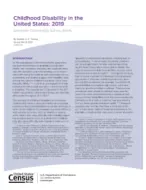An official website of the United States government
- //
- Census.gov [ attr(href) ] /
- Publications [ attr(href) ] /
- Childhood Disability in the United States: 2019
- About the Library [ attr(href) ]
- America Counts: Stories Behind the Numbers [ attr(href) ]
- Audio [ attr(href) ]
- By the Numbers [ attr(href) ]
- Fact Sheets [ attr(href) ]
- Infographics & Visualizations [ attr(href) ]
- Photos [ attr(href) ]
- Publications [ attr(href) ]
- Reference [ attr(href) ]
- Spotlights [ attr(href) ]
- Videos [ attr(href) ]
- Working Papers [ attr(href) ]
Childhood Disability in the United States: 2019
Introduction
As the population of the United States ages, there has been much focus on disability among older adults. Yet, childhood disability also warrants attention: the monetary and nonmonetary costs associated with caring for children with disabilities can be substantial, and studies suggest that disability rates among the nation's children have been rising since the early 1990s.
This brief uses 1-year estimates from the 2019 American Community Survey (ACS) to provide information about childhood disability in the United States. In addition to examining the prevalence of disability among children under the age of 18 in 2019, the brief assesses whether childhood disability differentially affected certain children and households within the United States in 2019. Finally, the brief draws on 1-year estimates from the 2008 ACS to compare childhood disability patterns in 2019 to patterns observed in 2008, when the current set of disability questions in the ACS was first introduced.
Highlights
- The percentage of children with a disability in the United States increased between 2008 and 2019, from 3.9 percent to 4.3 percent (Figure 4).
- The most common type of disability among children 5 years and older in 2019 was cognitive difficulty (Figure 3).
- In 2019, disability rates in the United States were highest among American Indian and Alaska Native children (5.9 percent) and lowest among Asian children (2.3 percent) (Figure 5).
- Childhood disability rates were lower among foreign-born children (3.2 percent) than among native-born children (4.2 percent) and lower among native-born children with one or more foreign-born parents (3.1 percent), relative to native-born children with only native-born parents (4.5 percent) (Table 2).
- While children in poverty were more likely to have a disability than children above the poverty threshold in 2008 and 2019, the prevalence of disability significantly increased for both groups over this period (Table 2).
- There were regional differences in childhood disability prevalence in 2019, with the highest rates observed in the South and the Northeast and the lowest rate observed in the West (Table 3). These regional patterns were somewhat similar to those observed for adult disability.
Others in Series
Publication | July 21, 2020
Supplemental Nutrition Assistance Program (SNAP) Receipt for Households: 2018
This report presents data on SNAP receipt during 2018 at the national and state levels based on the 2018 American Community Survey (ACS) 1-year estimates.
Publication | February 23, 2021
Same-Sex Couple Households: 2019
Information about the characteristics and geographic distribution of same-sex couple households using data from the 2019 American Community Survey (ACS).
Publication | February 09, 2021
Bachelor's Degree Attainment in the United States: 2005 to 2019
This brief uses three non-overlapping ACS 5-year estimates to examine bachelor’s degree attainment for the nation, counties and by race and Hispanic Origin.
Some content on this site is available in several different electronic formats. Some of the files may require a plug-in or additional software to view.
Sign Up for Email Updates
To sign up for updates please enter your contact information below.
Measuring America's People, Places, and Economy
